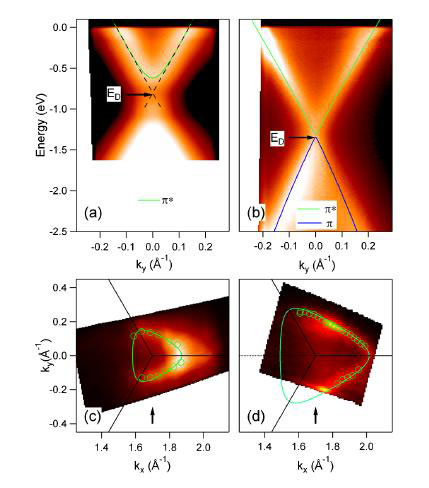| May 18, 2011 |
Evidence for graphene-sheet-driven superconducting state in graphite intercalation compounds
|
|
(Nanowerk News) Graphite intercalation compounds (GICs) are formed by the insertion of arrays of guest species between the layered sheets of the graphite host. This can greatly modify the electronic properties of the graphite and can lead to interesting phenomena, for example, superconductivity.
|
|
Research into superconductivity in GICs was reinvigorated by the discovery, at the London Centre foe Nanotechnology (LCN), of superconducting transition temperatures (Tc) orders of magnitude higher than the previous record, in CaC6 (Weller et al Nature Phys 1, 39 2005).
|
|
Despite significant recent activity in this area, the nature of the superconducting mechanism is still under debate. Although theory and experiment point towards conventional. electron-phonon mediated (BCS) superconductivity, some important details are still unknown. Most importantly, the exact identity of the electrons and phonons involved.
|
 |
| Electronic structure of LiC6 (left) and KC8 (right) Position of the Dirac point is marked (ED).
|
|
In a recent paper in Physical Review Letters ("Electronic Structure of Superconducting KC8 and Nonsuperconducting LiC6 Graphite Intercalation Compounds: Evidence for a Graphene-Sheet-Driven Superconducting State"), researchers from the Brookhaven National Laboratory, in collaboration with the London Centre for Nanotechnology (Chris Howard and Mark Ellerby), have mapped the electronic structure of superconducting GIC, KC8 and non-superconducting LiC6.
|
|
Their work exposes anomalies or kinks in the electronic structures of these materials arising from an electron-phonon interaction. Analysis of this data permits an extraction of the strength of the electron-phonon coupling which, together with similar data from CaC6, is shown to follow the trend in Tc in these materials.
|
|
The main finding is that electron-phonon coupling between graphene derived electrons and graphene derived phonons is sufficient to yield superconductivity without any contribution from intercalant derived electronic bands or phonons. This is important because it points towards superconductivity in the closely related and technologically relevant materials, carbon nanotubes and graphene.
|

